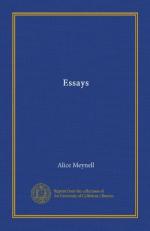What, then, about the plaid? Where is the natural fact there? If the Indian, by practising a non-natural art of spirals and zig-zags, cuts himself off “from all possible sources of healthy knowledge or natural delight,” to what did the good and healthy Highlander condemn himself by practising the art of the plaid? A spiral may be found in the vine, and a zig-zag in the lightning, but where in nature is the plaid to be found? There is surely no curve or curl that can be drawn by a designing hand but is a play upon some infinitely various natural fact. The smoke of the cigarette, more sensitive in motion than breath or blood, has its waves so multitudinously inflected and reinflected, with such flights and such delays, it flows and bends upon currents of so subtle influence and impulse as to include the most active, impetuous, and lingering curls ever drawn by the finest Oriental hand—and that is not a Hindu hand, nor any hand of Aryan race. The Japanese has captured the curve of the section of a sea-wave—its flow, relaxation, and fall; but this is a single movement, whereas the line of cigarette-smoke in a still room fluctuates in twenty delicate directions. No, it is impossible to accept the saying that the poor spiral or scroll of a human design is anything but a participation in the innumerable curves and curls of nature.
Now the plaid is not only “cut off” from natural sources, as Ruskin says of Oriental design—the plaid is not only cut off from nature, and cut off from nature by the yard, for it is to be measured off in inorganic quantity; but it is even a kind of intentional contradiction of all natural or vital forms. And it is equally defiant of vital tone and of vital colour. Everywhere in nature tone is gradual, and between the fainting of a tone and the failing of a curve there is a charming analogy. But the tartan insists that its tone shall be invariable, and sharply defined by contrasts of dark and light. As to colour, it has colours, not colour.
But that plaid should now go so far afield as to decorate the noble garment of the Indies is ill news. True, Ruskin saw nothing but cruelty and corruption in Indian life or art; but let us hear an Indian maxim in regard to those who, in cruel places, are ready sufferers: “There,” says the Mahabharata, “where women are treated with respect, the very gods are said to be filled with joy. Women deserve to be honoured. Serve ye them. Bend your will before them. By honouring women ye are sure to attain to the fruition of all things.” And the rash teachers of our youth would have persuaded us that this generous lesson was first learnt in Teutonic forests!




